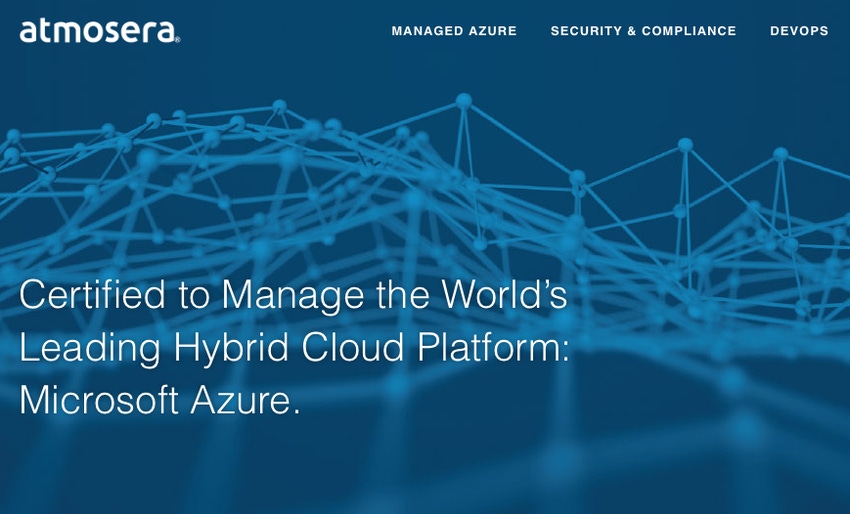The Doyle Report: Business Transformation Done Right
Atmosera, a fast-growing provider of managed services built around the Microsoft Azure platform, unveiled new capabilities on Tuesday, culminating a multi-year effort to transform the channel partner organization into a more robust technology company purpose-built for the digital services era.
June 27, 2017

Atmosera, a fast-growing provider of managed services built around the Microsoft Azure platform, unveiled new capabilities on Tuesday, culminating a multi-year effort to transform the channel partner organization into a more robust technology company purpose-built for the digital services era.
Officially today, Atmosera announced the expansion of its Atmosera Managed Azure Services. With the new enhancements, Atmosera customers can implement public, private and hybrid Azure environments that modernize existing systems, reduce management complexity and cut IT costs.
Though it may sound mundane, it’s not to Atmosera’s mid-sized and enterprise customers, which number in the hundreds and have headquarters in 40 states and 10 countries. Thanks to the changes that Atmosera has made, they can now give it a greater share of their IT budget—and more valuable work to boot.
To put itself in this position, Atmosera has had to transform its business—not once, but several times over the past few years. The changes were neither easy nor intuitive. But they have benefitted the company and provided a glimpse into how beneficial business transformation for channel companies can be.
Here’s its story.
Atmosera’s roots date back to 1995, when its forerunner, a company called EasyStreet, began providing basic Internet services to customers in the Portland, Ore. area. Throughout its existence, EasyStreet added capabilities as technology evolved. From Internet Service Provider (ISP), it layered on hosting capabilities, resale services and then managed services. In January 2013, EasyStreet merged with Infinity Internet of nearby Vancouver, Wash. The deal was underwritten by Seaport Capital, which thought the combined companies’ expertise in data centers, cloud computing and managed services had the potential to be something big. But what that was wasn’t immediately obvious.
Enter Jon Thomsen in January 2014. A corporate veteran who previously held senior executive positions at successful startups and Fortune 500 companies in the telecom, consumer packaged goods and energy industries, Thomsen saw an opportunity to reinvent the company. Instead of a mere provider of digital cloud services, he believed it could distinguish itself as a developer of them as well. But it would require a major pivot from the technology it supported and a new name, “Atmosera.”
Thomsen believed that hybrid clouds would soon become the platform of choice for Corporate America. At the time, however, Atmosera was focused on private clouds, co-location services and data center management. Thomsen recognized that the company needed a public cloud partner. Being from the Pacific Northwest, Atmosera naturally looked at both AWS and Microsoft.
“I told our board that we made the decision to pivot 100 percent to Microsoft and the Azure platform, in particular,” says Thomsen. Not everyone was onboard with the decision at the time, but Microsoft’s cloud platforms, broad ecosystem and partner support convinced Thomsen that he made the right decision.

Jon Thomsen, CEO, Atmosera
Not long after, Atmosera became one of the first Microsoft Cloud Service Partners (CSP). Later it became a Cloud OS Network (COSN) partner.
With its technology platform of choice decided, Thomsen then turned to the composition of the company’s workforce. When he arrived, EasyStreet was hardware and engineering-heavy, talent-wise. Thomsen recognized that certified hardware engineers were falling behind in the a new cloud and software-centric world. So he began rebuilding the workforce and the company’s culture around the vision of becoming the “Frisbee of flying disks for Azure.”
What Thomsen envisioned was a true utility company that could offer digital functionality by “the drink.” While the idea required plenty of networking engineers, systems administrators and infrastructure support specialists, it hinged on recruiting new software developers and sales specialists.
“Within our workforce we had some angst and confusion. People wondered ‘what does this mean for me?’” Thomsen recalls. “After we educated the workforce and showed people that they actually would get to work on really cool and interesting technologies and stay relevant in their skillset, 99.9 percent of our employees got it.”
To build utility services, Atmosera began hiring DevOps software developers in 2015 and 2016. Thomsen turned them onto building IP for its internal cloud environments before turning them onto Azure. In June 2016, Atmosera announced the Atmosera Azure Backup Service. A month later, it unveiled new cloud migration services. Then in April of this year, the company unveiled the industry’s first secure delete application for Azure Storage. The announcement Atmosera made Tuesday is, in essence, a repackaging all of its capabilities, references architectures, etc., into a platform that can be delivered in a consistent, repeatable way.
Armed with this capability, Atmosera can help customers assess, migrate and manage private, public or hybrid Azure cloud environments. In addition to basic managed services, Atmosera also provides enhanced security, compliance and disaster recovery services.
“We’ve been elevated up in the conversation stack and are having much more ‘C-level’ discussions [as a result],” says Thomsen.
While the changes have delivered growth, they have not been without risk. Developing software for the Azure stack, for example, means staying one step ahead of Microsoft itself. That’s no easy feat. But when you realize that Azure is really a collection of some 17,000 SKUs, there’s always some place where you can add value, Thomsen says.
What else? Talent recruitment remains a constant challenge. And so does the shifting competitive landscape. It’s creating new threats and opportunities that will likely lead Atmosera and its investor Seaport Capital to acquire some additional capabilities, which means additional complexity as it prepares to unveil some new services later this summer.
But that’s what Thomsen signed up for when he took over. Looking back, Thomsen says he believes he had no choice but to make the transformations that he initiated.
“If we had no done anything, I cannot imagine that we would have much of a future. The research from 451, Gartner and others in 2014 and 2015 all said the path to public cloud was through a private cloud… That was true all the way through 2016. But it has dramatically switched. I think we have sold two private clouds since September of 2016. Two. Everyone who is coming to us now wants public cloud and hybrid,” says Thomsen.
Fortunately, Atmosera is ready.
About the Author(s)
You May Also Like


